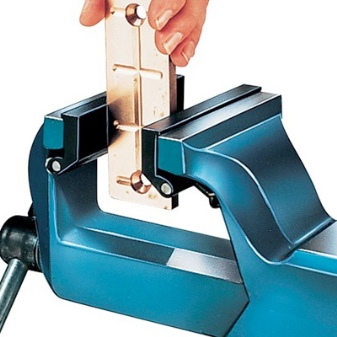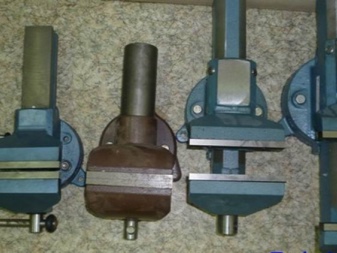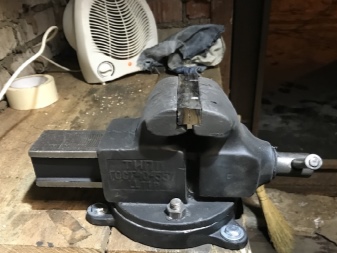Features of the selection and operation of locksmith vices

Every artisan person needs a tool such as a vise. There are several types of them, one of which is a locksmith's vice. To make the right choice, you need to have an elementary understanding of this tool.


Features and purpose
Any vice, including locksmith's vice, is mechanical device, the main purpose of which is to ensure reliable fixation of various workpieces and workpieces... They are also designed to free the hands of the master during work, which ensures accurate execution of actions (when drilling, notching). The vise promotes worker safety and minimizes physical and energy costs.
Since the design of the vice is simple, the scope of their application looks quite wide: the vice is used by both professionals in production shops and amateurs for repair work in home workshops.
Providing a secure fit, the vice guarantees high-quality workpieces.


The parts are fixed in a vice between 2 parallel plates by turning the handlewhich adjusts the clamping degree. In turn, the bench vice is securely fixed on a special stable workbench or work table.
A feature of this device is great strengthbecause in applications such as forging, chopping and riveting, an intense impact force is applied. Vices can be of various sizes: from lightweight small models to huge fixtures used in factory production.


What are they made of?
Regardless of the type, model and shape of the locksmith vice, they all have standard device in accordance with the requirements of GOST 4045-75, regulating the necessary design parameters and the nomenclature of parts. All models are arranged according to a certain scheme and consist of the following structural parts:
- stationary stable body-base;
- 2 jaw plates - movable and fixed (fixed jaw can have an anvil);
- clamping trolley, consisting of a screw and a nut;
- a rotary knob that rotates the screw clamp;
- spring and bushing;
- fixing mechanism to the desktop.

The vise kit also includes spare parts such as removable corrugated lip pads, providing a more reliable fixation of workpieces. Some expensive vise models can be equipped with pneumatic drive, and they are most often used in the factory.
The vise is fixed to the tabletop of the workbench. bolted or a special screw is used that secures the structure like a clamp... Communication between 2 sponges takes place by means of screw clampwhich is set in motion when the rotary knob is turned.
Thus, the position of the movable jaw changes in relation to the whole structure: it moves outward or inward, forming the required distance between the jaws and fixing the workpiece.


Specifications
Having the same design, a vise can have some distinctive characteristics: different shapes and different ratios of parameters such as length, width, height, weight and material of manufacture.
Materials (edit)
The strength of the material used to make the vice is an important characteristic. The materials for making metal locksmiths vice are usually carbon steel and gray cast iron.
Advantages cast iron consist in its high hardness and strength, corrosion resistance. It is resistant to rust and effectively dampens impact forces.


Models made from individual cast iron alloys, for example, from ferritic cast iron, have a high strength, which is almost 10 times the strength of gray cast iron. However, cast iron is brittle when subjected to intense impact and is heavy.
Steel products have greater versatility, since they can be used to process workpieces from different materials and perform delicate work, therefore they have a higher price.
By weight, they are lighter than cast iron, more compact and mobile. However, when exposed to moisture, they quickly rust.


Dimensions (edit)
The working dimensions of the vice are also of great importance: the width of the jaws and the depth of their opening (the course of the jaws). These parameters determine how deep and wide they cover the workpiece, as well as the dimensions of the parts to be machined - the larger the working dimensions of the jaws, the larger the workpieces can be processed.
The size of the jaws for different models can vary from 80 to 250 mm, and they can be maximally opened by 200-250 mm, the clamping force is 15-55 (F), the length of the entire structure is 290-668 mm, and the height is 140-310 mm.
The following types of vise for the house are distinguished by size (length, height, jaw stroke, weight):
- small vice - 290 mm, 140 mm, 80 mm, 8 kg;
- medium - 372 mm, 180 mm, 125 mm, 14 kg;
- large - 458 mm, 220 mm, 160 mm, 27 kg.


The weight
Weight is an equally important parameter, since the clamping force of the vice also depends on it. It is believed that weight affects the strength of the entire structure - the greater the mass, the stronger the vice.
The weight of different models can vary from 8 to 60kg.


Views
There are several types of locksmith vices.
Parallel
This type belongs to the machine vice. This is the most popular and demanded type of vise, since it allows you to process wood, metal, plastic products, as well as workpieces from other materials and long parts. Vices can be with manual drive, which causes the lead screw to move.
There are also improved models with modernized design, which allows them to be installed not only on the workbench, but also on the floor. In these models, the fastening mechanism has a simple device, and their installation is quick and easy.

Parallel models, in turn, are subdivided into several more types.
Swivel vise
They are designed so that the device can rotate.... The base of the case is securely and rigidly fixed to the desktop. The fixed jaw is equipped with a rotary part and is connected to the base by means of a guide screw with a handle, which allows the vice to rotate around an axis (vertical or horizontal) at an angle of 60-360 degrees. Thus, the vise can be rotated to every corner of the worktable.
The rotary vise allows you to change the position of the workpiece in order to process it at different angles. These models usually come with an anvil.

Fixed or stationary
This type has a non-rotating base, which is fixed on the workbench with bolts.... This vise can only be used in one position. To change the position of the workpiece, first unclench the jaws, manually change the position of the workpiece, and then fix it again.

Their used for processing small workpieceswhen the part cannot be held by hand, or to perform work and simultaneously hold the vice with one hand. If it is necessary to process the product with 2 hands, the manual vice is additionally fixed with parallel models.
These vices are small in size and are often used in everyday life to perform simple actions.


Chair models
Such a vice is used for laborious work with impact force (e.g. rivets). They are mounted on the edge of the desktop and are named after the chair-like retention element.
Their design feature is double fixation of the fixed jaw... The sponge is fixed to the horizontal surface by means of a foot (special plate). Its lower part is attached to the leg of the workbench. This mounting method is highly resistant to powerful side impacts.
Another feature is different direction of movement of the movable jaw: it follows an arc, not a straight path. The design makes it possible to work with products of complex configuration.

Pipe vise
Round parts cannot be machined in a conventional locksmith's vice. For this, there are pipe models. This vise has a concave jaw to securely hold tubes or round workpieces.
Depending on the type of fastening, in addition to stationary ones, there are also portable models that are fixed to the surface with suction cups or using clamps. The advantage of these types of fixation lies in the possibility of using it without a permanent workplace.
However, the clamp does not provide a sufficiently strong fixation of the tool, and the suction cups require a perfectly smooth and even surface of the working place.

There are also quick-clamping types of tools. Their feature is the presence of a quick-clamping mechanism, which shortens the installation time and provides convenience during operation. To set the jaws to the desired position, or, conversely, to open them, you do not need to manually rotate the clamping device, but you just need to pull the trigger.
Professional models locksmith vices may differ in larger dimensions, the presence of a large anvil, a thrust bearing on the screw, which simplifies the clamping of the part, adjusting screws to eliminate the gap.
Some models are equipped with a lifting mechanism. Such a vice allows you to carry out locksmith operations at different levels.

Manufacturers and models
Locksmith vices are available from many manufacturers. The most famous and well-established companies are considered to be the following.
- Wilton. The American manufacturer is a leader in the tool industry. Its branded products have quality certificates, meet international standards, and are distinguished by an affordable cost.

- "Bison". Domestic products are in demand not only in Russia, but also successfully compete with foreign brands. High-end equipment is of high quality.

- "Cobalt". The homeland of the brand is Russia, but production is carried out in China. Products of this brand are popular with both professionals and ordinary users, as they meet the requirements of quality and ergonomics.

- Jonnesway. The Taiwanese brand is also characterized by the production of quality tools that meet international and domestic safety and quality standards.

We should also note such popular brands as the German Dexx (production in India), the Canadian Fit, the joint Russian-Belarusian WEDO (production in China).
Rating of the best models of locksmith vice
- Wilton BCV-60 65023 EU. The model differs in its budgetary cost. Although the jaws open only 40 mm, their width is sufficient - 60 mm. Fixation to the workbench is carried out from below with a screw. Low weight (1.2 kg) allows you to transfer the instrument to another room. The sponges have a smooth surface that does not damage products made of soft material.

- Cobalt 246-029. This model of rotary vise has the following parameters: jaw stroke - 60 mm, their width - 50 mm.The body is cast iron, and the jaws are made of high quality steel. The advantage of the model is the ability to change the jaws.

- Jonnesway C-A8 4 "... Stationary model with 101 mm jaws and 100 mm travel. The lead screw is housed in a tubular housing to protect it from moisture and debris. The vice has a pivoting function and is capable of vertically fixing products.

- "Zubr" 32712-100. Vices differ in affordable cost. They provide a firm hold on the workpiece. The body and the movable jaw are made of high quality cast iron. The model has a swivel option.

- Wilton "Workshop" WS5WI63301. The tool is powerful and has a high clamping force and is designed for both professional use and home use. Jaw width - 127 mm, jaw stroke - 127 mm. There is an anvil on the fixed jaw. For the manufacture of body parts, the casting method was used, the sponges are made of high quality cast iron. The model has replaceable pads and a swivel option.

Which one to choose for a garage?
If you have a garage or workshop, it becomes necessary to purchase a locksmith vice. For small garage locksmiths (for example, assembling auto parts), classic parallel swivel vise models are the best option. When choosing a tool, you should pay attention to the following parameters.
- The size of the sponges. It is determined by the dimensions of the parts to be processed. To work in a garage, the size of the jaws should be from 100 to 150 mm, since these are the parameters that are most optimal for performing car repairs.
- Manufacturing material. Cast iron models with steel jaws are considered the best option.
- Installation method. To install the tool in a permanent room (garage), a vise with a stationary attachment to the workbench should be preferred. If a vice is necessary for rare use when necessary, then it is better to choose a model with a screw clamping mechanism.
- Versatility of the model... If it is necessary to work with products made of materials of varying degrees of hardness or different shapes (flat or round), a vice with replaceable jaws is required.
- Vise dimensions. If you intend to change the installation location of the tool, then you should choose lighter, more compact options.
- Product quality. When buying, you need to pay attention to the appearance of the model. The tool should be free of visible defects, burrs, sharp edges, distortions, and have a finished shape with straight lines. With a curvilinear configuration, the transition of the lines should be smooth. Threaded areas must be coated with grease, moving parts move smoothly, without jamming.


The warranty period is important as it certifies the quality of the tool.
The cost is determined by the characteristics of the operation: for professional intensive work, it is better to purchase a more expensive model, and for use at home, budget options are also suitable.
User manual
The service life of any equipment depends to a large extent on correct operation. Therefore, first of all, one should carefully study the instructionswhich is attached to the vise. It contains all the technical parameters of the tool, its functional features, installation and maintenance method.
The preparation of the tool and the rules of work consist in the following steps:
- install and fix the vice on the workbench, strictly following the instructions in the instructions;
- adjust the moving parts;
- the weight and dimensions of the workpieces to be processed must exactly correspond to the parameters specified in the instructions for which the vice is designed, and not exceed them;
- fix the part firmly by moving the movable jaw;
- after work, it is necessary to clean the tool from shavings, dirt, dust, and then lubricate the running gear and other rubbing parts.


When working, you must follow the safety rules:
- control the fastening of the vice for strength and reliability and exclude the possibility of spontaneous loosening of the clamping part;
- it is strictly forbidden to apply impact force to the tool handle, as well as lengthen it with a pipe or pin;
- heated metal workpieces must not be processed in a vice, since after cooling, the dimensions of the part change, which can lead to a weakening of its clamping in the jaws and injure the worker;
- the level of force provided by the instructions must not be exceeded.


The above information can help the average consumer decide on the choice of model.
For an overview of popular models of locksmith vices, see the following video.













The comment was sent successfully.